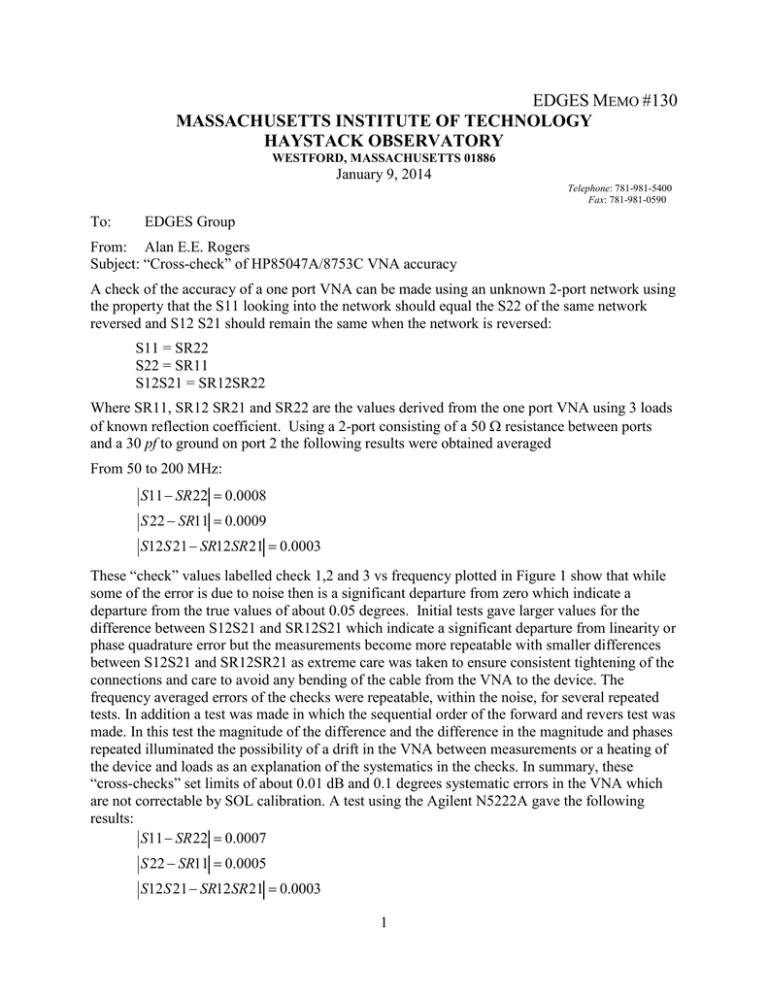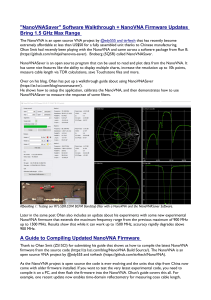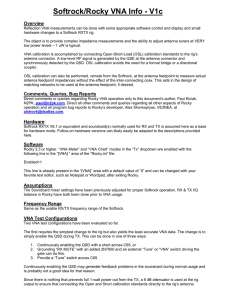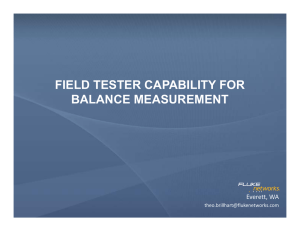EDGES M #130 MASSACHUSETTS INSTITUTE OF TECHNOLOGY
advertisement

EDGES MEMO #130 MASSACHUSETTS INSTITUTE OF TECHNOLOGY HAYSTACK OBSERVATORY WESTFORD, MASSACHUSETTS 01886 January 9, 2014 To: Telephone: 781-981-5400 Fax: 781-981-0590 EDGES Group From: Alan E.E. Rogers Subject: “Cross-check” of HP85047A/8753C VNA accuracy A check of the accuracy of a one port VNA can be made using an unknown 2-port network using the property that the S11 looking into the network should equal the S22 of the same network reversed and S12 S21 should remain the same when the network is reversed: S11 = SR22 S22 = SR11 S12S21 = SR12SR22 Where SR11, SR12 SR21 and SR22 are the values derived from the one port VNA using 3 loads of known reflection coefficient. Using a 2-port consisting of a 50 Ω resistance between ports and a 30 pf to ground on port 2 the following results were obtained averaged From 50 to 200 MHz: 0.0008 S11 − SR 22 = 0.0009 S 22 − SR11 = 0.0003 S12 S 21 − SR12 SR 21 = These “check” values labelled check 1,2 and 3 vs frequency plotted in Figure 1 show that while some of the error is due to noise then is a significant departure from zero which indicate a departure from the true values of about 0.05 degrees. Initial tests gave larger values for the difference between S12S21 and SR12S21 which indicate a significant departure from linearity or phase quadrature error but the measurements become more repeatable with smaller differences between S12S21 and SR12SR21 as extreme care was taken to ensure consistent tightening of the connections and care to avoid any bending of the cable from the VNA to the device. The frequency averaged errors of the checks were repeatable, within the noise, for several repeated tests. In addition a test was made in which the sequential order of the forward and revers test was made. In this test the magnitude of the difference and the difference in the magnitude and phases repeated illuminated the possibility of a drift in the VNA between measurements or a heating of the device and loads as an explanation of the systematics in the checks. In summary, these “cross-checks” set limits of about 0.01 dB and 0.1 degrees systematic errors in the VNA which are not correctable by SOL calibration. A test using the Agilent N5222A gave the following results: 0.0007 S11 − SR 22 = 0.0005 S 22 − SR11 = 0.0003 S12 S 21 − SR12 SR 21 = 1 Which are similar, but with lower noise (see Figure 2) than the results obtained with the older HP 85047A/8753C. The VNA calibration for these tests was done outside the VNA by measuring the S11 of the calibration open, short and load. These data were then used to solve for the calibration using the a model for the open and short of 16.684 ps one-way delay and 1.3 Gohm/s loss. The load was essentially a perfect 50 ohms, while the results of these checks are not very sensitive to the impedance of the load or the loss of the open and short they are extremely sensitive to the delay of the open and short as 1 ps at 200 MHz is 0.05 degrees. With calibration each test requires 9 measurements making the test, when done manually extremely challenging and emphasizes the importance of consistent tightening of the open, short and load. Added note: A defect in the HP85047A/8753C was discovered when comparing measurements of the S-parameters a 25 ft long LDF-2 cable with a model for the cable. When the S12S21 product was compared with the model it was noticed that a phase jump of 0.05° occurred at 61 MHz and returned at 121 MHz. Upon further investigation it was discovered that this was due to a frequency error of about 2 kHz in the VNA scanning process. Errors in frequency cannot be detected by the method described in this memo and it was only the large delay of this cable that made the small frequency error detectable. It is not yet know if frequency errors in this VNA are repeatable and can be corrected. 2 Figure 1. Check 1,2 and 3 for HP85047A/8753C from thin to thick traces. 3 Figure 2. Result for N5222A 4




